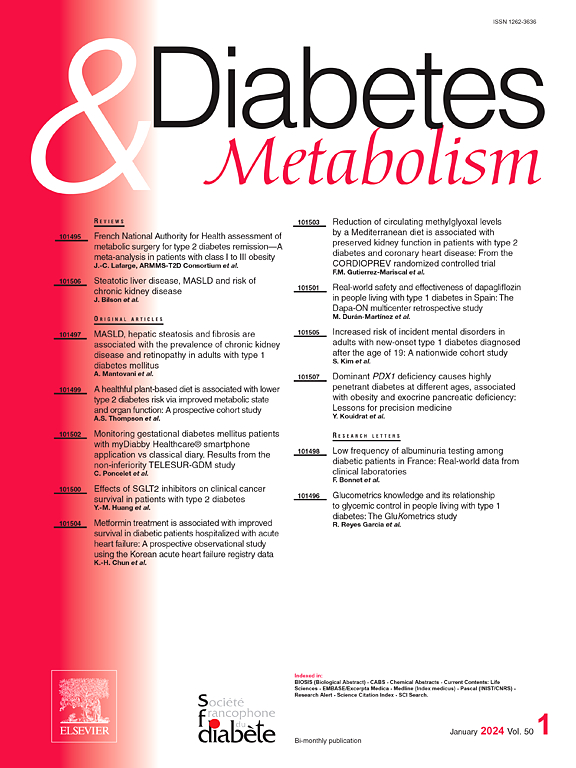Exploring perceived barriers to physical activity among individuals with type 1 diabetes in the era of new technologies: An analysis from the BETTER registry
IF 4.7
2区 医学
Q1 ENDOCRINOLOGY & METABOLISM
引用次数: 0
Abstract
Objective
We aimed to identify barriers to physical activity for people living with type 1 diabetes (PwT1D) and their relationship with sociodemographic and disease-specific factors.
Methods
- Cross-sectional study with BETTER registry participants (>14 years) who completed the BAPAD1 (Barriers to Physical Activity in T1D) questionnaire. An item with a score of 5 or more was defined as a barrier. Participants were categorized into 4 subgroups based on their insulin therapy and blood glucose monitoring modality: 1) multiple daily injections (MDI) without continuous glucose monitoring (CGM), 2) MDI with CGM, 3) continuous subcutaneous insulin infusion (CSII) with CGM, and 4) automated insulin delivery system (AID).
Results
Among 1117 participants, the main perceived barrier was fear of hypoglycemia. BAPAD1 scores were similar across all subgroups, but more individuals in the AID group perceived "fear of hypoglycemia" and "loss of control over diabetes" as barriers. Being female, having a low income or education level, being overweight or obese, taking medication for depression, younger diabetes, higher HbA1c, presence of microvascular complications, and lack of confidence in managing hypoglycemia were associated with higher BAPAD1 score.
Conclusion
Fear of hypoglycemia remains the main barrier to physical activity for PwT1D. Technological advances alone are not sufficient to reduce perceived barriers to physical activity, highlighting the need for complementary educational and behavioral interventions.
探索新技术时代1型糖尿病患者身体活动的感知障碍:来自BETTER注册表的分析
目的:-我们旨在确定1型糖尿病患者(PwT1D)的身体活动障碍及其与社会人口统计学和疾病特定因素的关系。方法:-对BETTER注册中心的参与者(> - 14岁)进行横断面研究,他们完成了BAPAD1 (T1D身体活动障碍)问卷。得分在5分或以上的项目被定义为障碍。根据胰岛素治疗和血糖监测方式将参与者分为4个亚组:1)每日多次注射(MDI)不进行连续血糖监测(CGM), 2) MDI合并连续血糖监测(CGM), 3)连续皮下胰岛素输注(CSII)与CGM, 4)胰岛素自动输送系统(AID)。结果:在1117名参与者中,主要的感知障碍是对低血糖的恐惧。所有亚组的BAPAD1得分相似,但AID组中更多的个体认为“害怕低血糖”和“失去对糖尿病的控制”是障碍。女性、收入或受教育程度低、超重或肥胖、服用抑郁症药物、糖尿病年轻化、HbA1c较高、存在微血管并发症以及对低血糖管理缺乏信心与较高的BAPAD1评分相关。结论:对低血糖的恐惧仍然是PwT1D患者进行体育活动的主要障碍。仅靠技术进步并不足以减少人们所认为的身体活动障碍,这突出表明需要补充教育和行为干预措施。(图1)。
本文章由计算机程序翻译,如有差异,请以英文原文为准。
求助全文
约1分钟内获得全文
求助全文
来源期刊

Diabetes & metabolism
医学-内分泌学与代谢
CiteScore
12.00
自引率
4.20%
发文量
86
审稿时长
13 days
期刊介绍:
A high quality scientific journal with an international readership
Official publication of the SFD, Diabetes & Metabolism, publishes high-quality papers by leading teams, forming a close link between hospital and research units. Diabetes & Metabolism is published in English language and is indexed in all major databases with its impact factor constantly progressing.
Diabetes & Metabolism contains original articles, short reports and comprehensive reviews.
 求助内容:
求助内容: 应助结果提醒方式:
应助结果提醒方式:


